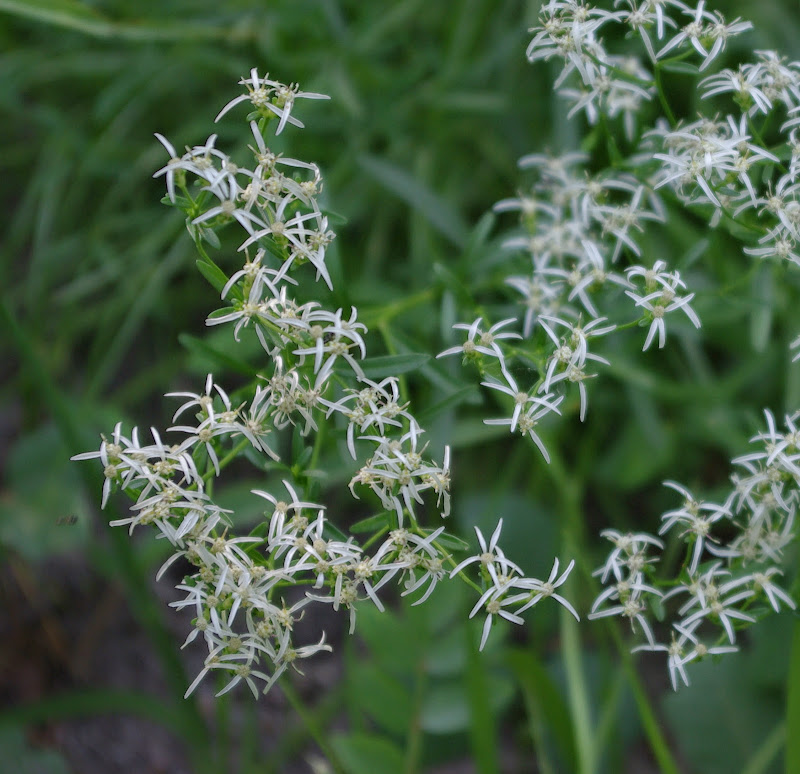The daffs and tommies (Crocus tommasinianus, planted in the sunken Baptisia pots to keep them safe from marauding voles) are in bloom a month early. There's even a few natives displaying their delicate flowers among the miniscule new greenery: Blue Violets, Jacob's Ladder, Woodland Phlox, and Marsh Violets.
Time to prune the apple trees. Last fall I posted about looking for new apple trees as the two we have were setting lots of fruit that was then dropping off. We're keeping the 12-year-old trees and giving them another go. It's normal for apple trees to shed some of their fruit prematurely (this self-thinning is called June drop), and perhaps the apple trees dropped all of their fruit because they were heat and drought stressed. We mulched them well over the winter and DH pruned them this year. Maybe the problem is that when I pruned them I pruned them for more flowers rather than maximum yield. lol Last fall I looked at ordering from two different nurseries: Big Horse Creek Farms in the NC mountains and Century Farm Orchards in Reidsville about an hour north of Greensboro. Big Horse Creek custom grafts trees for customers; if you order in spring they will graft a sapling, grow it up over the summer and then ship it in the fall, which is a really nice customer service. I wanted to go ahead and order some dwarf apple trees last fall so I contacted Century Farm about available trees on dwarf rootstock. From their list of a half dozen trees I picked two old southern varieties with good disease resistance, Aunt Rachel and Yates. Aunt Rachel is from Chatham County (central) NC. Fruit ripens early, late July to early August, green and red striped apples with firm juicy mildly tart flesh good for eating and cooking. Yates was developed in GA before 1860. Fruit ripens in October and is a good keeper. The tender flesh is juicy and aromatic and was historically used for cider and eating.
While some gardeners have already started their tomato seeds, I'm still deciding which ones to use this year. Last year was such a fail for our tomatoes in spite of planting them in a brand new garden patch that we're going to grow them in half wine barrels this year. I might start the leftovers seeds from last year:
Roma (determinate, verticillium and fusarium wilt resistant)
Eva Purple Ball (indeterminate, heirloom from the Black Forest region of Germany)
Druzba (indeterminate, heirloom from Bulgaria)
Black Brandywine (indeterminate, heirloom)
Chadwick Cherry (indeterminate, heirloom)
I just ordered Neptune, Ozark Pink and Tropic from Southern Exposure Seed Exchange after they came up in a google search for best tomatoes/ hot summers. I want some other black tomatoes also just for taste. I love the sweet acid taste of the Black Russian tomatoes but they're not the most disease resistant tomato. Even if I just get a few I'll be happy. I ordered seeds for Black Prince, Japanese Black Trifele, and Paul Robeson from Southern Exposure Seed Exchange. I'll probably also get the "super tomatoes" (resistant to just about everything) Bella Rosa and Fletcher from Totally Tomatoes. I will order some cherries too since they seem to be tougher than the regular tomatoes. I'm considering Black Cherry, Black Plum, Brown Berry, Purple Haze, and Matt's Wild Cherry. Any other suggestions for tomatoes to try would be welcome.
DH wanted to know what I'd like in the vegetable garden since our tastes don't always match. He likes cabbage and greens but I won't touch them. I only eat okra if it's breaded and fried, not just sauteed naked. Otherwise it's slimy, blech!! I tried looking through the Territorial Seeds catalog and while the choices looked great, I had no idea how those plants would do in our muggy heat. Territorial is out of Oregon so their recommends aren't really relevant. So I turned to Southern Exposure Seed Exchange and decided on the following:
Christmas Pole Lima Bean (I meant to order King of the Garden)
Lazy Wife Greasy Pole Snap Bean (so called because the beans grow in clusters and are easy to pick, and because the hairless pods are shiny, thus the term "greasy")
Silver Queen Corn
Kansas Muskmelon (cantaloupe)
Spaghetti Squash (really is as good as pasta with a good sauce)
Rose Finn Apple Fingerling potato
The Black Swallowtails requested more parsley plants please, so I ordered 2 packets of Italian flat-leaf parsley and two packs of Bronze Fennel seed as well.


















































